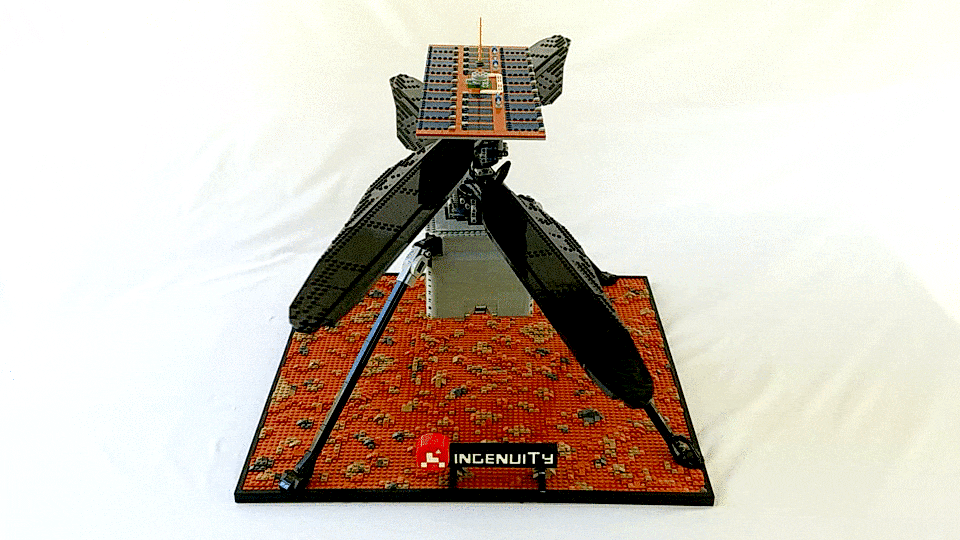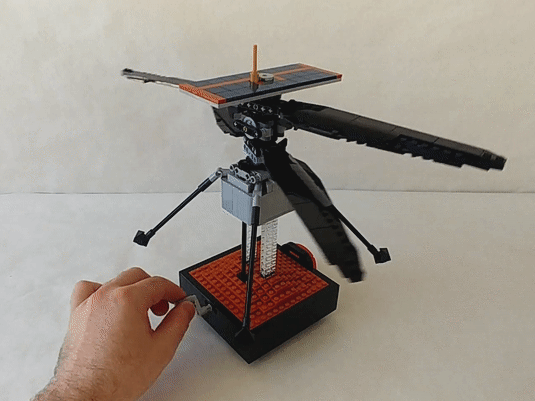MOC on Mars: Perseverance and the Ingenuity Helicopter

To mark the announcement of LEGO’s new Technic 42158 NASA Mars Rover Perseverance, we thought we would republish an exceptionally nerdy article about an actual MOC on Mars.
Today we showcase the first LEGO Ingenuity helicopter (complete with instructions) built by engineer Stephen Pakbaz who worked on the actual Perseverance chassis which is now roaming our neighboring Red Planet. This article was originally published on June 13, 2021.
You are probably more familiar with builder Stephen Pakbaz than you realize. In fact, Stephen designed the fifth LEGO Ideas set, the iconic 21104 Curiosity Rover. Every year, Stephen brings out-of-this-world (sorry, I had to) motorized content to the space theme at Bricks LA. It feels like next year might give us those thrills again.

Stephen has given us a preview of the good things we’ll have on the other side of lockdown, this time by building a stunning 1:1 scale LEGO model of the Ingenuity helicopter that deployed on Mars from the Perseverance rover in April of this year. He also built a mini version of Ingenuity, which you’ll see a little further in. Spoiler alert: they both move, just like the real thing! Stephen was gracious enough to share some deep, nerdy intel on his newest space MOCs.

At BrickNerd, we typically like to include a photo of a builder with their LEGO, but in this case, here’s Stephen with one of his non-LEGO MOCs: the actual Perseverance chassis that is actually roving on the actual planet Mars.

Gwyneth: Thank you for speaking with BrickNerd! Before we talk about the LEGO spacecraft, can you please describe your profession to set the scene?
Stephen: I am a Mechanical Engineer in the Structures & Configuration Group at the Jet Propulsion Laboratory (JPL). While I have always had this title at JPL, there are different levels that come with experience. I started at Level I and am now at Level III. The first spacecraft I ever worked on was the Curiosity Rover, designing simple brackets and performing tests. Afterward, I went on to build and test the main instrument for the GRAIL (Gravity Recovery And Interior Laboratory) Spacecraft, which successfully mapped the gravity field of the Moon. I then spent some time at another company designing TESS (Transiting Exoplanet Survey Satellite), which has gone on to discover 126 exoplanets with 2,686 planet candidates that have yet to be confirmed.
For the Perseverance Rover, I was the Lead Engineer responsible for building the entire Chassis, which was quite a step up from the small parts I made for the Curiosity Rover. Currently, I am working on the Europa Clipper Spacecraft that will explore Jupiter’s Moon, Europa. Since high school, I always wanted to be involved in exploring Europa, an ice-covered moon with a planet-wide liquid water ocean underneath that could potentially support life, so I’m very excited for this mission and I definitely plan to turn it into a LEGO model!
Gwyneth: Every one of these projects is utterly fascinating! But since we’re specifically nerdy about the brick, I must take us back to Earth: When did you start working on this LEGO model? Did it start off with the smaller scale MOC or did you expect to build a 1:1 model?
Stephen: I began working on my full-size Ingenuity model around March 2020, but initially I intended to create a Perseverance model that would have been very similar to my Curiosity Rover LEGO set. However, the building process wasn’t as satisfying this time around. Since the two rovers are very similar, most of the mechanical challenges were already solved, leaving mostly cosmetic updates. It was at this time that I realized that many space and LEGO fans would also likely take my Curiosity Rover and update it into their own versions of Perseverance. This is indeed what happened around the time the Perseverance Rover landed and it was wonderful seeing all of them appear online.
My attention eventually turned to the newest and most experimental part of the mission, the Mars Helicopter Scout, which is what Ingenuity was called before it got a proper name. For several years, I had wanted to make a spacecraft or part of a spacecraft at a 1:1 scale to show at LEGO conventions, and the Ingenuity Helicopter seemed like the perfect mechanical challenge that would also impress the public. This would also be my largest MOC and took about a year to finish. In between this effort, I developed a 1:3 scale Ingenuity model, posted it on LEGO Ideas, and shared free step-by-step building instructions on Rebrickable, like I did with my Curiosity Rover model, so others could learn more about this incredible vehicle.

Gwyneth: Let’s get the nerdy details out of the way. What are all the important scales and specs?
Stephen: The rotors on my 1:1 scale Ingenuity Helicopter are 150 studs (4 feet or 1.2 meters) from tip-to-tip, which I think is accurate to the nearest stud. The whole thing, from the bottom of the baseplate to the tip of the communication antenna is about 72 studs (22.7 inches or 57.6 centimeters) tall. The motor spins the rotors at about 5-6 rpm. This is more than 400x slower than the 2400 rpm of the real Helicopter, but I still find it quite mesmerizing to look at. The span of the rotors for my 1:3 scale model is, of course, 50 studs and the spin rate is only limited to how fast one can turn the handle at the back of the model, though I imagine it would tear itself apart before it got to 2400 rpm.
Gwyneth: Did you build the LEGO models during the building of the real rover or perhaps after to commemorate it being finished? How does your creative process intersect with your role in the real-life phenomenon?
Stephen: I was working on a different MOC while building the real Perseverance Rover and didn’t start on the Ingenuity models until I had already moved on to the Europa Clipper Spacecraft. Similarly, I didn’t create my Curiosity Rover LEGO model until I had moved on to working on the GRAIL Spacecraft. Now that I think about it, when it comes to creating LEGO models of spacecraft I’ve worked on, I seem to create the LEGO version in the period that comes after working on the real one and before it launches.
Gwyneth: Do you usually build MOCs of equipment that you see at work? Do your coworkers give feedback in the process?
Stephen: I tend to build MOCs that showcase some sort of mechanism or interesting geometry. This preference works well for spacecraft and explains the similarities between my career and hobbies. I’m also more of a solitary builder and like to take my time (which is why I’ve turned down multiple offers to be on the LEGO Masters TV show, although I enjoy watching it). I’ll often spend a year or more to complete large projects. Progress typically comes in bursts with long pauses in between. During these pauses, I’ll often divert my attention to a smaller build to keep things interesting. I don’t often share my progress with coworkers or friends unless I need some motivation to finish something.

Gwyneth: Were there exponentially greater hurdles building the larger version beyond "upscaling"? Does the smaller model also move?
Stephen: Mechanically, I think the 1:1 scale Helicopter was actually easier to build than the 1:3 scale model. Both versions have similar geared mechanisms to spin the rotors in opposite directions. The larger model uses a motor housed in the main body while the smaller version has a hand crank on the back of the base (though one could easily replace it with a motor). The larger Helicopter allowed for more flexibility and space to work out the mechanism while I was much more restricted in what I could fit into the smaller model. Overcoming the mechanical challenges for both models was very satisfying, but I think I enjoyed getting the smaller model to work just a little bit more.

Gwyneth: Did you have access to the plans for the real thing and decide to build a LEGO version from there or the other way around?
Stephen: When I was helping design the Perseverance Rover Chassis, I was involved in the effort to find a place on the Rover to attach the Helicopter. As the task was passed on to other engineers, I kept informed of the progress. During this time, I learned a lot about the design, which certainly helped when creating the LEGO models. The Helicopter wasn’t always guaranteed to be part of the mission, but everyone involved was excited and determined to make it work. Creating a LEGO model of this novel form of space exploration was just my way of expressing support and enthusiasm for the project.

Gwyneth: Normally, a builder hates the question about "how many parts," but did you need to have a grasp of part quantity for a 1:1 scale model? Did you design it digitally?
Stephen: I don’t yet know exactly how many pieces are in my 1:1 scale model, but I think it’s a lot fewer than you would expect for its size. The baseplate is pretty flat, the landing legs are long and skinny, the main body isn’t very big, and the rotors and solar panel are quite thin and flat. So while the overall model occupies an impressive amount of space, most of that space is empty. My current best guess is around 4,000-5,000 pieces.
Like most of my models, I started designing it on graph paper in order to figure out the mechanics and geometry. Normally, I create digital models of my creations at the end of the building process, so I’ll have a record of my design, which also makes it easier to share with other builders. However, since this model was larger than anything else I had previously attempted, I found it necessary to design it digitally as I built it so I could get a grasp on the pieces I would need to purchase in order to have the parts in the colors and quantities necessary.
This included lots of black parts for the rotors and a big box of dark orange plates for the Martian landscape. At the time, I wasn’t sure what I wanted the landscape on the baseplate to look like, so I overestimated how much dark orange I would need, but I’m sure those extra parts will come in handy for some future Mars model!

Gwyneth: How does the weight of a 1:1 model affect the model, especially the movement?
Stephen: The real Ingenuity Helicopter is about four pounds and according to my kitchen scale, the 1:1 Ingenuity model, without the baseplate, is about seven pounds. A significant portion of that weight is in the rotors and even though they rotate smoothly and are perfectly balanced, I wouldn’t be surprised if they put a little more strain on the motor than it is supposed to handle, but it’s been running pretty well so far. All this weight rests on long skinny legs and the rotors spin around a thin central axis, so there is also some noticeable twisting in the model when starting and stopping the rotors, but it stabilizes again once the rotors reach a constant speed.
Gwyneth: Please talk about the movement. It's all powered by one motor? Is it really very complicated Technic work, or is it more straightforward than one might think? How did you calibrate the movement to be in line with the original?
Stephen: The model is powered by a single Power Functions XL Motor, Battery Box, and IR Receiver. The rotors are connected to Large Technic Turntables with a few more gears connecting the rotors together and to the motor. The gearing itself isn’t very complicated, but a lot of Technic structure was required to hold it all together and make it as sturdy as possible. The real Helicopter is powered by separate motors located above each rotor, but due to space limitations, having a single motor located in the main body was the most feasible solution for my model.

Gwyneth: Did you encounter any structural instabilities building in LEGO that the real spacecraft didn't deal with because of its weight/materials?
Stephen: The real Ingenuity Helicopter had the advantage of using carbon fiber composites, metals, and other exotic materials that allowed it to achieve the maximum strength and function at the lightest weight. Conversely, being limited to plastic LEGO pieces did present some interesting, but not insurmountable challenges. For example, my 1:1 Ingenuity model cannot support its own weight. The thin landing legs would just spread out until they break. However, pinning the legs to the baseplate helped to create a much more solid structure.
While JPL Engineers and LEGO Designers have extensive testing programs to ensure the quality of their products, I had the advantage of a dedicated feline assistant, named Sunspot, who just loved to test the integrity of my 1:1 Ingenuity model by jumping up on the table, walking under the landing legs, and rubbing her chin on the edges of the rotors. Her constant nudging and prodding certainly helped me to find and reinforce any weak points.
Gwyneth: That’s a purrfect solution! (Sorry, I had to.) You started building this project right when the pandemic started. Did "quarantine" play any role in the development of your model?
Stephen: Quarantine definitely affected the development of my 1:1 scale Ingenuity model. A major motivational factor for me to complete the MOC was so I could display it at LEGO conventions and other public events. (The only place I have enough room to run it at home is on my dining room table or in my backyard.) As opportunities for such displays disappeared, so did my motivation to finish the MOC.
This is when I focused my attention on making the 1:3 scale model. It was the smallest scale that I could achieve while still including a mechanism to show off the spinning rotors. I then posted it on LEGO Ideas and shared free step-by-step instructions on Rebrickable so people could build their own model and learn about how it would pioneer historic new advancements in space exploration.

My motivation to finish the 1:1 scale model returned as Perseverance approached its scheduled landing on February 18, 2021. This is also when the pandemic situation started looking more hopeful. I wasn’t sure when things would be totally back to normal, but I wanted to be ready when they were.
Gwyneth: Many people build with LEGO to forget the stress of work, but you often build your work projects a second time at home. Do you feel that LEGO building is an extremely different experience from rover building, or do you feel that the two experiences build or feed off each other?
Stephen: I have found that some of my most productive periods of building with LEGO have occurred when things were more stressful at work. I’m not sure how that works or where the extra energy comes from, even though my career and hobby are obviously connected. I think building LEGO spacecraft models is an effective way for me to share my excitement for space exploration.
In fact, the last part and most difficult part of the 1:1 model was creating the landscape for the base. I was originally thinking of something with little hills and craters that would have looked nice, but were more suitable for a smaller scale model. It wasn’t until the real Ingenuity Helicopter was deployed onto the surface of Mars and returned pictures of its landing site that everything made more sense. As planned, the real Helicopter was set down on terrain that was as flat as possible, which makes a lot of sense when you’re dealing with an experimental aircraft. The only other features at the deployment site were pebbles and bits of rock poking through the topmost layer of Martian dust. This was the final bit of knowledge I needed to finish my model and I have been very satisfied with the results.

Gwyneth: You mentioned the lack of space at home. Is this model modular, or do you foresee challenges transporting it to display in public when that's possible again?
Stephen: I built the 1:1 scale Ingenuity model with the original intent of bringing it to LEGO conventions and other events related to space exploration, so making it easier to break down and reassemble was always something I had in mind during the build. The rotors and major components of the Technic structure are held together with a lot of 32054 Technic friction pins with bushings on the end so I can easily pull them out to take things apart for transportation or making repairs. The rotors can be further split in half, the solar panel and legs are pretty easy to disassemble, and the baseplate breaks down into four sections. I haven’t had the opportunity to display it at any events yet, but I’ll be ready when that time comes!
Thanks to Stephen Pakbaz for the out-of-this-world interview! You can follow his future LEGO projects on Flickr. And an interplanetary-sized thanks to Nathan Hagan for his work editing the photos in this article to really make them shine!
What other real-life space exploration technology have you seen built out of LEGO? Will you build Stephen’s Ingenuity Helicopter MOC? Leave your observations and thoughts in the comments below.
Do you want to help BrickNerd continue publishing articles like this one? Become a top patron like Charlie Stephens, Marc & Liz Puleo, Paige Mueller, Rob Klingberg from Brickstuff, John & Joshua Hanlon from Beyond the Brick, Megan Lum, Andy Price, John A., Lukas Kurth from StoneWars, and Wayne Tyler to show your support, get early access, exclusive swag and more.

